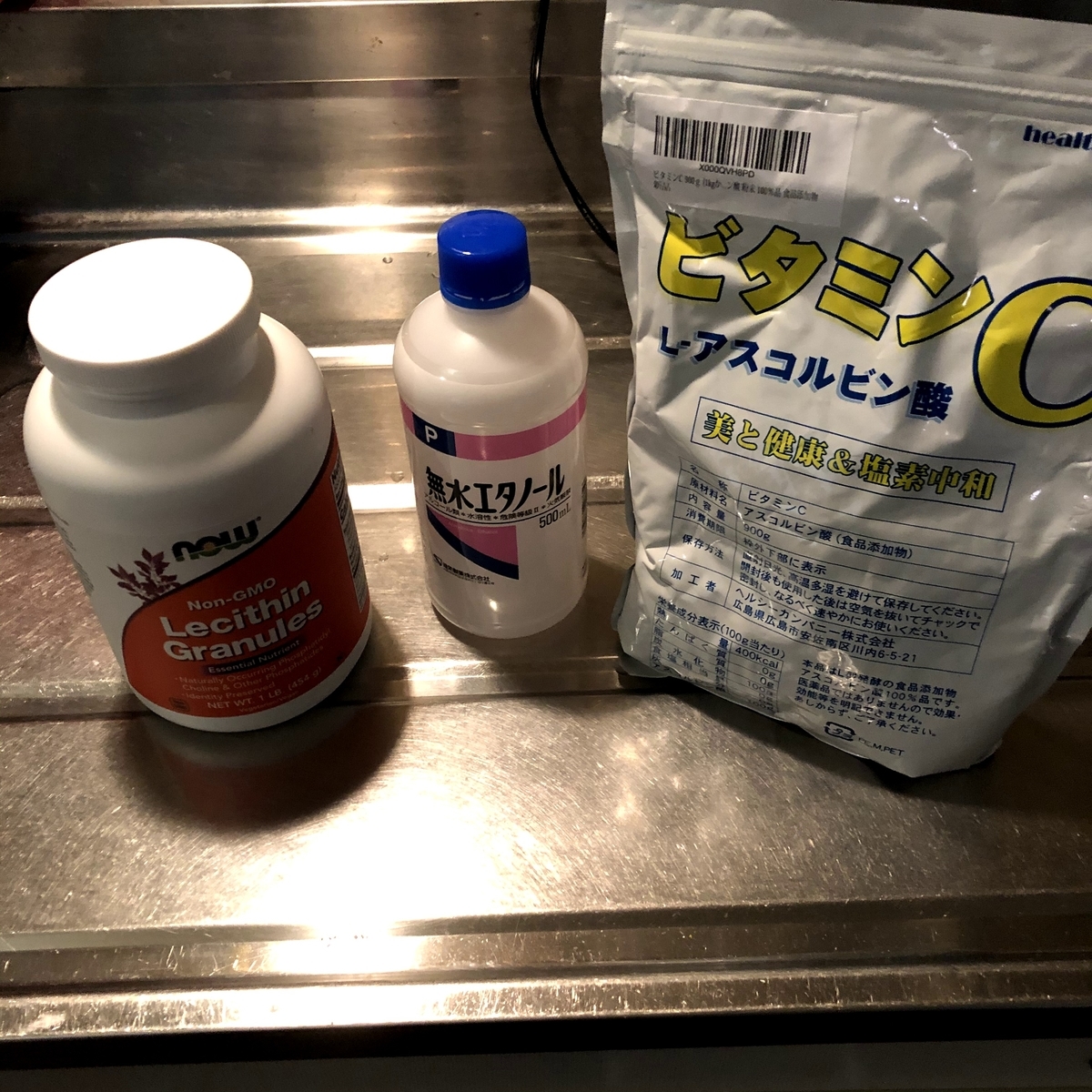■
自作リプライセルの作り方
最近美容ブロガーや美容界隈で話題になっている「飲むビタミンC点滴」とも称されるリプライセルビタミンC
この記事ではそのリプライセルビタミンCの解説と実際に私が行っている自宅でできる自作リプライセルの作り方についてご紹介します。
目次
なぜこの記事を書くに至ったか
ニキビなどの肌荒れやシミ(色素沈着)などの肌のトラブルにお悩みの方は男女問わず多いことと存じます。市販の塗り薬やサプリメント、皮膚科の薬や高額な美容商品にも手を出したけどどれも大きな効果は感じられなかった、根本的な解決には至らなかった・・・そういう方は多いのではないでしょうか?
実際に私も中学生の頃からかれこれ6年以上ニキビに悩まされており、赤くなったニキビ跡を人に見られるのがどうしても嫌でマスクなしでは外に出られないほどコンプレックスになっていました。色々と試行錯誤を繰り返しあらゆる美容商品やサプリメントに手を出しましたし生活習慣や食事にも極力気を使ってはいましたが何をどうしても肌の治安が改善することはありませんでした。
そんな時に出会ったのがこのリプライセルビタミンCであり、半信半疑で飲み始めたところ、おおよそ一週間で明らかかつ大きな効果を感じました。小さな面ぽう(白い皮脂のつまり)はできることがあってもそれが赤く化膿する前にどんどん角質が剥がれ落ちていき腫れたニキビができることがなくなったのです。この体験は半分絶望し肌について諦めかけていた私に大きな希望を与えてくれました。
しかし、Amazonや他通販サイトで販売されているリプライセルはどれも30包で5000円前後と、若い世代にとっては決して安いとは言えない価格であり、1日1包飲むと仮定して年間で6万円以上のコストになります。
いくら美容のためとはいえサプリメントに年間6万円のコストは安いとは言えません。
そうして色々と悩んでいる私にある友人がリプライセルの自作方法について記された海外の資料が存在することを教えてくれました。
今回はその資料を読んで自分なりに理解した内容を翻訳及び加筆した上で皆様に共有させていただきます。
リプライセルとは
リプライセルビタミンCとは現在はリポスフェリックの商品名で米国LivOn Laboratories社から発売されているビタミンCサプリメントです。この商品における通常のビタミンCサプリメントとの大きな違いはビタミンCをそのまま摂取するのではなく、リポソームというリン脂質の特殊な化学的構造によってビタミンCが分子レベルでカプセル化されている点です(詳しくはwikipediaのリポソームの項目を参照してください)。リン脂質とは一般に総称してレシチンと呼ばれるもので全身の細胞の細胞膜の主要な成分として使用されています。このリン脂質によるカプセル化により消化過程でビタミンCが破壊されることを防ぎ、腸壁を容易に通過し、血液中に流れ込んだ後に体中の奥深くの組織までこれを浸透させることを可能とします。そしてそのすみずみまで行き渡ったリプライセルの外膜にあたるリン脂質部分が体中の細胞に細胞膜の材料として使用される際にカプセル化されていたビタミンCが外膜をはぎ取られ、放出されることであらゆる組織の深部までビタミンCを届けることを可能としていると考えられています*1。
コスパ比較
(注意:下記の情報は2020/11/28時点のものを元にしたものです)
Amazonで販売されている製品版リプライセルの価格は正規輸入品で30包5500円
全体で171ml、1包5.7mlなので
5.7mlで約183.33円となり1mlあたり32.16円となります。
対してこのレシピにおいて使用されるリプライセルの原料の価格はそれぞれ
レシチン 1gあたり約2.80円
ビタミンC 1gあたり約1.11円
エタノール 1gあたり約4.78円
水 1gあたり約・・・知らん
であり400mlのリプライセルを作るのに必要なコストは約639.2円となります。
これは1mlあたり約1.6円となり、製品版リプライセルとの価格差は20倍にもなります。
つまり自作することで20倍安くリプライセルを摂取することが可能ということです。
製品版リプライセルの1包と同じ量を毎日摂取するとして年間でのコストは
製品版 66915円
自作 3329円
(小数点以下は四捨五入しています)
となりその差は歴然です。
用意するもの
必須アイテム
・ビタミンC粉末
・顆粒レシチン
・無水エタノール
・温度計(100℃まではかれるものが望ましい)
・500mlビーカー
・キッチンスケール(0.1g単位ではかれるものが望ましい)
・水道水(契約しましょう)
あると便利なもの
・ガラス棒(混ぜれるものなら何でもOK、粘土が高いのでスプーンとかだと余計に付着してもったいない)
・任意のサイズのビーカー(キッチンスケールで量り取った材料を入れておくのに便利、容器なら何でもOK)

自作リプライセルのレシピ
このレシピにおいては完成品の容量がおおよそ400mlになります。
準備
まず下準備としてそれぞれの材料を以下の重量分キッチンスケールなどで任意の容器に量り取っておいてください。
水 238.8g
エタノール 57.4g
ビタミンC 80.2g
レシチン 98.5g
※小数点以下は適当でいいです





①エタノール水溶液の作成

②ビタミンCを溶液に溶かす
①で生成したエタノール水溶液にビタミンCを溶かします。


右の写真では温度計は20℃を指しています。
常温では完全に溶解しないため湯煎するなどして40℃前後まで温めます。


右の写真では温度計が40℃を指しており、沈殿物がないためビタミンCが完全に溶解したことがわかります。
沈殿したビタミンC粉末が完全に溶解したことを確認したら次のステップに進みます。
③溶液とレシチンを混合
②で生成した溶液とレシチンをブレンダーに入れて4分ほど撹拌します。


②で生成した溶液にレシチンを十分に溶解させるために溶液の温度が40℃前後に温まっていることが理想的です。


少々わかりにくいですが上の写真はブレンダーで撹拌中の混合液です。


十分にレシチンと溶液が混ざったら一度冷蔵庫にいれて冷却します。
④撹拌と冷却を繰り返す
十分に冷えたらまたブレンダーで撹拌します。2~3分ほど撹拌したらまた冷蔵庫にいれて冷却します。できるだけ多くのレシチンをビタミンCと結合させるためにこのプロセスを2,3時間おきに合計で5,6回ほど繰り返します。
この時③の最初の撹拌をのぞいて液体の温度が32℃を超えないように注意してください(ブレンダーの撹拌による摩擦で温度が上昇します)。加熱しすぎるとカプセルが破壊されてしまいます。
このプロセスの完了によって溶液中のビタミンCの7割以上がレシチンと結合しカプセル化されます。
通常④のステップでリプライセルは完成ですが全てのビタミンCのカプセル化には至っていません。超音波洗浄機を用いることで100%カプセル化されたリプライセルを生成することが可能です。より完全なカプセル化を望まれる方はステップ⑤に進んでください。
超音波洗浄をお持ちでない方は⑤と⑥のステップはスキップし、ステップ⑦に進んでください。
⑤超音波照射による泡の除去
このステップでは混合液から泡を除去します。最後にもう一度ブレンダーで混合液を撹拌したあと、30度℃付近まで温まった混合液をビーカーにそそぎます。

このレシピにおいては500mlビーカーが丁度よいサイズになります。


また、上の写真のようにダンボールを適当な大きさに切って中央にビーカーの底部と同程度の半径の穴を作ることでより超音波の照射がしやすくなります。私は割り箸とセロテープを使って補強するなどしています。
混合液を入れたビーカーにラップをして超音波洗浄機の水槽に浸し30分ほど超音波を照射します。
超音波洗浄機付属の金網ネットは超音波出力が低下するため使わないことをおすすめします。

混合液の泡がビーカー上部にたまってきたらこのステップは完了です。冷蔵庫にいれてしばらく冷却します。
⑥断続的に超音波を照射
より完全なカプセル化のために断続的な超音波照射を行います。混合液の入ったビーカーを超音波洗浄機の水槽に浸し混合液の温度が32℃に達しないくらいの時間幅で超音波を照射します。1回につき20分ほどが目安と考えてください。
20分程度の超音波照射が完了したら冷蔵庫で1時間ほど冷却します。混合液が累積で1時間の超音波照射をうけるまでこのプロセスを繰り返します。1回につき20分の場合は3~4回このプロセスを繰り返すと良いでしょう。カプセル化が解除されないために温度は32℃を上回らないように注意してください。
⑦泡を捨てて完成
混合液の上部にたまった泡をスプーンなどですくって捨てた後、タッパーや瓶などの任意の保存容器に混合液をうつして完成です。

上の写真ではまだ泡が残っているのが確認できます。
保存は必ず冷蔵庫で行ってください。
このレシピにおいて作成された混合液には1mlあたり約200mgのカプセル化されたビタミンCが含まれています。これは大さじ一杯(15ml)あたり約3000mgのビタミンCが含まれていることになります。
用語解説
・レシチン
リン脂質の総称。ある時点まではリン脂質の一つであるホスファチジルコリンのみを指す用語であったが現在ではホスファチジルコリン、ホスファチジルセリン、ホスファチジルイノシトール、ホスファチジルエタノールアミン、及びその他多くのリン脂質全般を指す用語として定着している。レシチン - Wikipedia
2020/11/28:詳しい用語や器具の解説や製造途中の写真については追って加筆いたします。もう少々お待ち下さい。
2021/02/15:製造途中の写真を追加しました。
※本記事の情報において計算の参考となっている為替レートや販売価格は全て2020/11/28時点のものであり、有為転変の宇宙においてそれらは時間と共に常に変動します。
為替レートは2020/11/28 15:00時点における1ドル(USD)104.07円(JPY)のレートを参考にしています。
また、本記事の内容を元に自作したリプライセルを販売するなどして商業利用することはLivOn Laboratories社に対する特許侵害などの法的問題に発展する可能性があります。当ブログと当ブログの著者はそれらに係るあらゆる法的問題について一切責任を負いかねますのであらかじめご了承ください。
D City Rock feat. Debra Zeer
D City Rock feat. Debra Zeer
作詞 LISA
作曲 TeddyLoid
唄 TeddyLoid
My name is Panty, the crazy sexy blondie and I'm not dumb
(私の名前はパンティ、イカれたセクシーブロンドだけどバカじゃない)
I'm breaking the news, now boys! Us girls we're full-time horny too !
(ボーイズ、いいことを教えてやるよ!私ら女はいつだってエロい気分なんだ!)
Hey, check out that hot one, damn he's got a big one *** delicious
(ねえあのイケてるアイツ、あのビッグな***超おいしそう)
It's time to get dirty now, so will y'all excuse me read the air ! I'm busy !
(ヤりたくなってきたから悪いが失礼!空気読めよ!私は忙しいんだ!)
Garterbelt ! Again you've dialed D-CITY 2-900
(ガーターベルト!もう一度ダテンシティ2-900番に電話してみてよ!)
Pantsu line ! Copy that ! Clear the city !
(神のお告げよ!OK!街をキレイにしろとの指令だ!)
Anarchy ! Everyone wants to be me !
(アナーキー!みんな私になりたいんでしょ!)
Anarchy yeh ! Get it up so I can see !
(アナーキーにね!起きてよ!私にも見えるように!)
Anarchy ! Let it flow wild and free !
(アナーキー!本能と自由に身をまかせて!)
Anarchy yeh ! Ya'll ready for the gig ?!
(アナーキーにね!ライブの準備はできた!?)
By the way, my name is Stocking, I spill venom stinging eros
(そして私の名前はストッキング、あふれる毒舌でエロスに駆り立てるわ)
And I got sweet tooth for rollipops loli goth, I lick good !
These stripes will strip you down.
(このしましまがあなたたちを溶かしちゃうわ)
I got no mercy for chiralism
(チラ見せなんて許さないわ)
My fans they all love me cuz I kick it real tasty
(私がいい感じにぶっ飛ばせばいつもファンは私に夢中なの)
I get high being nasty !
(悪いことするのって最高!)
Garterbelt ! You keep slappin' my butt around
(ガーターベルト!あいつはいつも私のお尻を叩いてくるの)
Pantsu line ! Freaky girl comin' your way !
(神のお告げよ!イカしたガールの登場よ!)
Anarchy ! Everyone wants to be me !
(アナーキー!みんな私になりたいんでしょ!)
Anarchy yeah! Standing ovation please !
(アナーキーにね!スタンディングオベーションでよろしく!)
Anarchy ! Shake that thang wild and free !
(アナーキー!野生と自由で揺り動かして!)
Anarchy yeah ! Standing ready for the gig ?!
(アナーキにね!立って!ライブの準備はいい!?)
I know you know... those wings inside of you
(私は知ってるよ・・・あなたの中の2枚の翼)
I know you know... they do get naughty too
(わかってるよ・・・あいつらだっていけないことをしてるんだ)
Before I go...there's something I wanna say
(私が行ってしまう前に・・・言っておきたいことがあるの)
Your sleepy anarchy...Wake it up! Wake it up !
(あなたの眠れしアナーキーよ、立ち上がれ!羽ばたいて!)
Anarchy ! Everyone wants to be me !
(アナーキー!みんな私になりたいんでしょ!!)
Anarchy yeh ! Get it up so I can see !
(アナーキーにね!私にも見えるようにさ!!)
Anarchy ! Let it flow wild and free !
(アナーキー!本能と自由に身を任せてね!!)
Anarchy yeh ! Ya'll ready for the gig ?!
(アナーキーにさ!みんな準備はできてるんでしょ!!)
Although the future is a closed book
Anyone doesn't know what happens next moment.
Even Laplace's demon also does.
We don't have any choice except making the patterns as many as possible.
A current standard is no more than a current standard.
Certainly , the future is a closed book. But we can't know inside a closed book from what we can see now.
What we have to do as we prepare for indeterminate selection pressure is making and keeping diversity as much as possible.
Because we can never judge what establishes the evolution finally , by the current standard , and in the current environment.
If we managed to carry out evolution based on the current standard and ideology , can that evolution keep up holding our superiority in the future , in the environment of indeterminate ?
And then , also the reasonableness and benefits of the concept to be the center of the current human rights thought , like freedom , equality , love , and mutual recognition , is able to be explained by applying that theory.
With beyonding something religious , moral and ethical , this theory is quite concerned with the possibility that civilization and species can survive.
In the future , we have to verify how each variation affects about life and death of the civilization systematically and logically at both micro and macro view.
次の瞬間何が起こるかは誰にもわかりません
ラプラスの悪魔にとってもそれは同じでしょう
唯一できることは最多のパターンを用意することです
現在の価値基準は現在の価値基準でしかありません
未来は未知であるが故に「未来」なのです
一寸先は闇ですが明るみから闇は探ることはできません
未知なる淘汰圧への最も堅固な対策は可能な限り多様化することです
ダーウィンの進化論を優勢思想の根拠とするのは非常にナンセンスと言えます
なにをもって進化とするかは現環境の現価値基準では判断しかねるからです
現時点の価値基準や思想を元に恣意的な進化を遂げたとして、それが未来の、未知の環境下での優位性を担保してくれるでしょうか
ファシズム体制の本質的な問題点はここにあるでしょう
また、平等、自由、博愛、相互承認といった今般の社会思想、人権思想の枢軸となる概念の合理性とメリットもこの理論を適用すれば説明がつきます
これは宗教や倫理、道徳上の問題に留まらず、実際に文明と種の存続可能性に大きく関係しています
私達は自分自身のあり方や思想や人道のあり方について考える際に、常に文明の繁栄と存続をそれらの目的として定義するべきだと思います
一つ一つの変化が文明の存亡にどのような影響を与えるか、それをミクロとマクロの両視点において体系的かつ論理的に検証することが求められる時代です
※文法や単語の間違いがあったらコメントなどで教えていただけると助かります
なぜ今更ブログという化石サービスを始めるに至ったのか
ブログをはじめた理由はTwitterにも書いたとおりタイムライン方式のSNSだとなかなか気軽に思考を吐露できないからというのが大きい
自分はSNSでつぶやくとき常にフォロワーひとりひとりがその書き込みをどのように受け取るか、どのような表現にすれば当たり障りのない文言になるか、といった面倒なことをいちいち考えてしまうタイプで、色々と推敲した結果練りだされた文章がもともと頭で思っていたこととかけ離れたイメージになってしまうことが多いことに気がついてしまった
これでは結局あまり発散にも整理にもなっていないし、甚だしくは人の感性を推し量ったりそれに伴い毎度推敲作業にあたることで一回一回の書き込みにかかる労力がかさんで結果的に書き込むこと自体が面倒になってTwitter自体を放置してしまうという経験が何度もあった
これでは全くの本末転倒だし、Twitterから距離をおいたとしても思ったことを書き残したい、共有したいという欲求がなくなるわけではないのでこのフラストレーションによって慢性的にQOLが低下してしまう
その解決策としてこの都度ブログを開設することにした
実は以前から友人に勧められてはいたが・・・何事も三日坊主で終わってしまう性分の自分に続けられるのか?という不安から今日に至るまで決断を保留していた
Twitterは文字数制限があって、長文を連投するとフォロワーのタイムラインを汚してしまうという懸念があるし、重たい話題やセンシティブな話題の書き込みは人の楽しい時間や感情体験に水をさしてしまうのではという心配がいつもあった
これらはタイムライン方式のSNSが他人のタイムラインに対してこちらから投稿を挿入するという形式をとっているからで、自分の書き込みという行為が能動的に他人の「読む」を作り出してしまう構図になっていることが自分にとっての問題の根っこだった
実質的に一斉送信メールと変わらないこの構図が自分の体質にはあまり合わないのではないかと思ったのだ
対してブログというのは受動的な発信方法で、ブックマークとかSNSのリンクから読み手側が「しょうがねぇ たまには読んでやるか( ー`дー´)」って気分のときに読んでもらえるので上に書いたような心配はほとんどしなくていいし文字数制限もないからお得意のくだらない妄想も書きたい放題
もちろんこんな心配すること自体が異常でSNSというのは本来もっと気軽に書き込むべきものなのでしょう・・・
ただ、ミュートされたりブロ解されたらいやだな・・・という気持ちが強い自分はついついTwitterでは本質的な部分に触れるのを躊躇してしまう
これからはTwitterは日常的なこと専用、ブログでは無制限というようにうまく使い分けていけたらいいなと思う
はじめてブログ調の文章を書いたから個人的に読み返してものすごい違和感があるけど・・・こういうのを書くのも慣れていけたらいいと思う


 1
1




